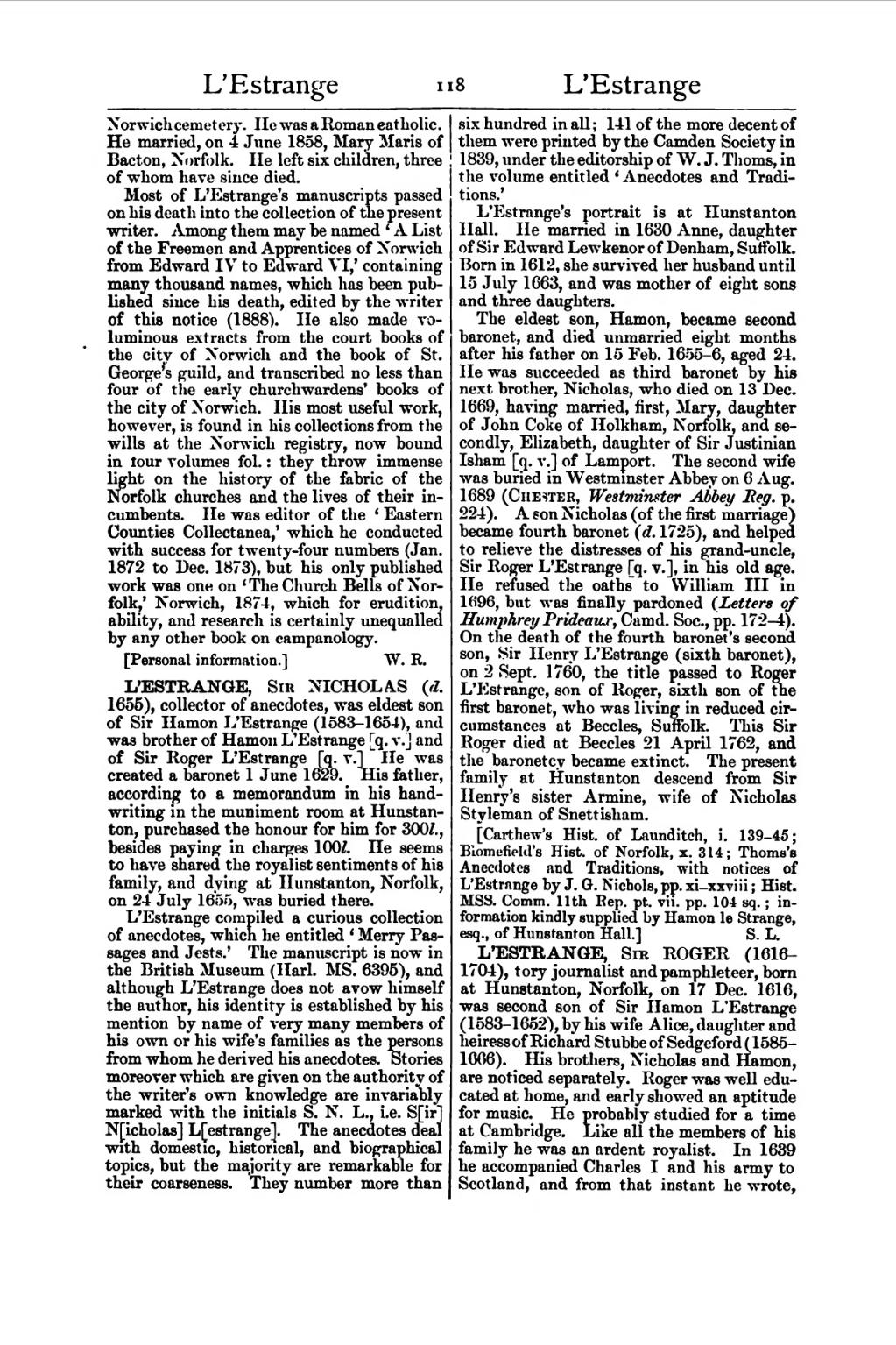Norwich cemetery. He was a Roman catholic. He married, on 4 June 1858, Mary Maris of Bacton, Norfolk. He left six children, three of whom have since died.
Most of L'Estrange's manuscripts passed on his death into the collection of the present writer. Among them may be named ‘A List of the Freemen and Apprentices of Norwich from Edward IV to Edward VI,’ containing many thousand names, which has been published since his death, edited by the writer of this notice (1888). He also made voluminous extracts from the court books of the city of Norwich and the book of St. George's guild, and transcribed no less than four of the early churchwardens' books of the city of Norwich. His most useful work, however, is found in his collections from the wills at the Norwich registry, now bound in four volumes fol.: they throw immense light on the history of the fabric of the Norfolk churches and the lives of their incumbents. He was editor of the ‘Eastern Counties Collectanea,’ which he conducted with success for twenty-four numbers (Jan. 1872 to Dec. 1873), but his only published work was one on ‘The Church Bells of Norfolk,’ Norwich, 1874, which for erudition, ability, and research is certainly unequalled by any other book on campanology.
[Personal information.]
L'ESTRANGE, Sir NICHOLAS (d. 1655), collector of anecdotes, was eldest son of Sir Hamon L'Estrange (1583–1654), and was brother of Hamon L'Estrange [q. v.] and of Sir Roger L'Estrange [q. v.] He was created a baronet 1 June 1629. His father, according to a memorandum in his handwriting in the muniment room at Hunstanton, purchased the honour for him for 300l., besides paying in charges 100l. He seems to have shared the royalist sentiments of his family, and dying at Hunstanton, Norfolk, on 24 July 1655, was buried there.
L'Estrange compiled a curious collection of anecdotes, which he entitled ‘Merry Passages and Jests.’ The manuscript is now in the British Museum (Harl. MS. 6395), and although L'Estrange does not avow himself the author, his identity is established by his mention by name of very many members of his own or his wife's families as the persons from whom he derived his anecdotes. Stories moreover which are given on the authority of the writer's own knowledge are invariably marked with the initials S. N. L., i.e. S[ir] N[icholas] L[estrange]. The anecdotes deal with domestic, historical, and biographical topics, but the majority are remarkable for their coarseness. They number more than six hundred in all; 141 of the more decent of them were printed by the Camden Society in 1839, under the editorship of W. J. Thoms, in the volume entitled ‘Anecdotes and Traditions.’
L'Estrange's portrait is at Hunstanton Hall. He married in 1630 Anne, daughter of Sir Edward Lewkenor of Denham, Suffolk. Born in 1612, she survived her husband until 15 July 1663, and was mother of eight sons and three daughters.
The eldest son, Hamon, became second baronet, and died unmarried eight months after his father on 15 Feb. 1655–6, aged 24. He was succeeded as third baronet by his next brother, Nicholas, who died on 13 Dec. 1669, having married, first, Mary, daughter of John Coke of Holkham, Norfolk, and secondly, Elizabeth, daughter of Sir Justinian Isham [q. v.] of Lamport. The second wife was buried in Westminster Abbey on 6 Aug. 1689 (Chester, Westminster Abbey Reg. p. 224). A son Nicholas (of the first marriage) became fourth baronet (d. 1725), and helped to relieve the distresses of his grand-uncle, Sir Roger L'Estrange [q. v.], in his old age. He refused the oaths to William III in 1696, but was finally pardoned (Letters of Humphrey Prideaux, Camd. Soc., pp. 172–4). On the death of the fourth baronet's second son, Sir Henry L'Estrange (sixth baronet), on 2 Sept. 1760, the title passed to Roger L'Estrange, son of Roger, sixth son of the first baronet, who was living in reduced circumstances at Beccles, Suffolk. This Sir Roger died at Beccles 21 April 1762, and the baronetcy became extinct. The present family at Hunstanton descend from Sir Henry's sister Armine, wife of Nicholas Styleman of Snettisham.
[Carthew's Hist. of Launditch, i. 139–45; Blomefield's Hist. of Norfolk, x. 314; Thoms's Anecdotes and Traditions, with notices of L'Estrange by J. G. Nichols, pp. xi–xxviii; Hist. MSS. Comm. 11th Rep. pt. vii. pp. 104 sq.; information kindly supplied by Hamon le Strange, esq., of Hunstanton Hall.]
L'ESTRANGE, Sir ROGER (1616–1704), tory journalist and pamphleteer, born at Hunstanton, Norfolk, on 17 Dec. 1616, was second son of Sir Hamon L'Estrange (1583–1652), by his wife Alice, daughter and heiress of Richard Stubbe of Sedgeford (1585–1666). His brothers, Nicholas and Hamon, are noticed separately. Roger was well educated at home, and early showed an aptitude for music. He probably studied for a time at Cambridge. Like all the members of his family he was an ardent royalist. In 1639 he accompanied Charles I and his army to Scotland, and from that instant he wrote,
